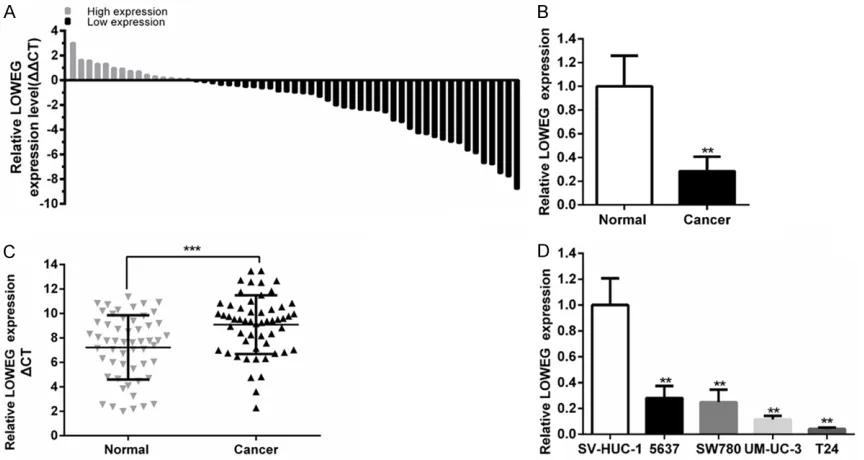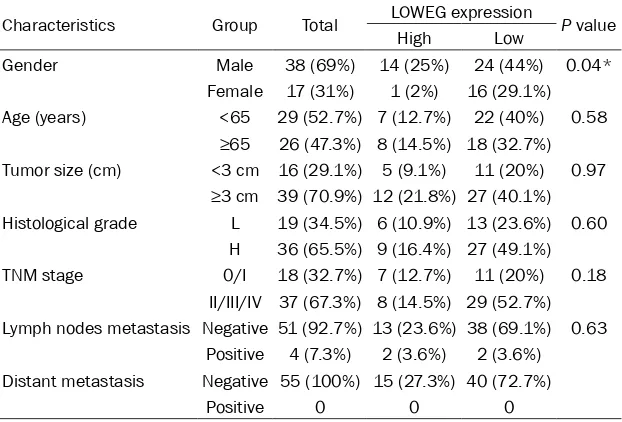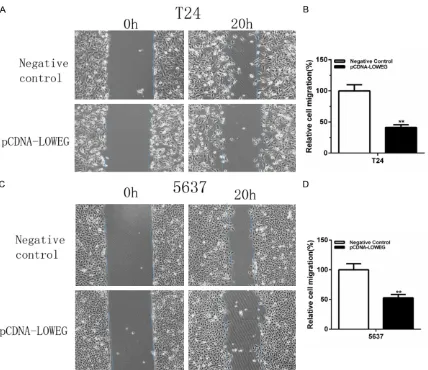Original Article
Over-expression of long noncoding RNA LOWEG
inhibits cell migration in human bladder cancer
Xinhui Liao1,2*, Anbang He2*, Jianhua Zhong2*, Feng Wang2, Hongbing Mei2, Jianting Wu2, Jieqing Chen2, Zhaojie Lv2, Xintao Zhang2, Jianli Chen2, Hongmei He2, Wanlong Tan1
1Department of Urology, Nanfang Hospital, Southern Medical University, Guangzhou, Guangdong, China; 2 Depart-ment of Urology, Shenzhen Second People’s Hospital, The First Affiliated Hospital of Shenzhen University, Shen -zhen, Guangdong, China. *Equal contributors.
Received March 2, 2017; Accepted May 3, 2017; Epub June 1, 2017; Published June 15, 2017
Abstract: Accumulating evidences demonstrated that lncRNAs function as potential oncogenes or tumor suppres-sor genes to play vital regulatory roles in tumorigenesis and tumor progression. LncRNA-LOWEG, a 331-bp lncRNA encoded on human chromosome 5, acts as a tumor suppressor gene which inhibits tumor cells invasion by up-reg-ulating the LIFR expression at the translational level in gastric cancer. However, the significance of lncRNA-LOWEG in bladder cancer is largely unknown. The relative expression levels of lncRNA-LOWEG in BC and BC cell lines were determined by quantitative RT-PCR (qRT-PCR). The relationships between lncRNA-LOWEG expression levels and the clinical characteristics were assessed. LncRNA-LOWEG expression was increased by transfecting a pcDNA-LOWEG vector. We used both wound healing assay and transwell assay to detect cell migration. The relative expres-sion levels of lncRNA-LOWEG was remarkably down-regulated in bladder cancer tissues compared with adjacent noncancerous tissues (P<0.05). LncRNA-LOWEG expression was also significantly down-regulated in four bladder cancer cell lines (P<0.01). Compared with the negative control group, pCDNA-LOWEG mediated over-expression of lncRNA-LOWEG significantly inhibited cell migration capability of bladder cancer T24 and 5637 cells, suggesting that up-regulated lncRNA-LOWEG expression could suppress the metastasis capability of bladder cancer. These findings reveal lncRNA-LOWEG acts as a tumor suppressor in bladder cancer, contributing to tumor migration, and may function as a novel candidate biomarker and a potential therapeutic target for patients with BC.
Keywords: LOWEG, bladder cancer, LncRNAs
Introduction
Human bladder cancer, as one of the most common genitourinary tumors, has captured our attention in recent decades because of its incidence and mortality [1, 2]. Despite tradi-tional therapies for patients with bladder can-cer are mainly surgery, chemotherapy and radi-ation therapy, the specificity, efficiency and 5-year survival rate remain frustrated [2, 3]. Therefore, in order to developing an effective diagnosis and targeted therapy, there is indis-pensable to reveal the underlying pathogenetic mechanism of bladder cancer as well as find new candidate specific biomarkers and poten-tial therapeutic targets which can be applied to precision medicine of BC.
With the fast development of sequencing tech-nology, a tremendous amount of long
LOWEG in human bladder cancer
RNA extraction and qRT-PCR
Total RNA was isolated from bladder cancer tis-sues and their adjacent normal tistis-sues or cells after transfection using the Trizol reagent (In- vitrogen, Carlsbad, CA, USA) according to the manufacturer’s protocol. cDNAs were synthe-sized by utilizing Prime Script RT Reagent Kit with gDNA Eraser (Takara, Dalian, China). The quantitative real-time polymerase chain reac-tion (qRT-PCR) was executed by using SYBR Green PCR kit (Takara, Dalian, China) accord- ing to the manufacturer’s instructions. Glyce- raldehyde 3-phosphate dehydrogenase (GAP- DH) was measured as an internal control. The primer sequences were as follows: lncRNA-LOWEG primers: 5’-CCCAGAAGTTTTCAGCCCT- CA-3’ (forward) and 5’-GACACTTTCCTTCATGGA- ATTTG-3’ (reverse), and GAPDH primers: 5’-CG- CTCTCTGCTCCTCCTGTTC-3’ (forward), 5’-ATCC- GTTGACTCCGACCTTCAC-3’ (reverse). The reac-tions were executed using an ABI PRISM 7300 Fluorescent Quantitative PCR System (Applied Biosystems, Foster City, CA, USA) in triplicate. The average value in each triplicate was used to calculate the relative amount of lncRNA-LOWEG by using 2-ΔΔCt methods.
Wound healing assay
The cell motility assay was detected by wound healing assay. At 24 h post transfection, a wound field was created using a sterile 200 μl pipette tip in about 90% confluent cells. The cells were incubated for 20 h at 37°C, and then the migration of cells was monitored with a digi-tal camera system. The software program HMIAS-2000 was applied to calculate the cell migration distance (um).
Transwell assay
The cell motility assay were also performed using a transwell insert (8 μm, Corning). 24 h after transfection, 1×105 cells were first starved in 200 μl serum-free medium and then put in the uncoated dishes. The lower chambers were filled with 700 μl medium containing 10% FBS. The cells were cultured for 48 h at 37°C in a 5% CO2 atmosphere and then the cells that had migrated to the bottom surface of the filter membrane were stained with 0.5% crystal vio-let solution and photographed in five preset fields per insert.
the effects of lncRNA-LOWEG expression on bladder cancer cells in vitro. Further experi-ments demonstrated that the overexpression of lncRNA-LOWEG could inhibit migration of the bladder cancer cell lines.
Materials and methods
Patient samples
In the present research, 55 patients with uro-thelial neoplasms of the bladder who received radical cystectomy were included. The bladder cancer tissues and their adjacent normal tis-sues were snap-frozen in liquid nitrogen rapidly after resection. The study was approved by the institutional research ethics committee of Shenzhen Second People’s Hospital. Moreover, written consent was received from each pati- ent.
Cell lines and cell culture
Human bladder cancer T24, 5637, SW780 and UM-UC-3 cells and SV-40-immortalized human uroepithelial cell line (SV-HUC-1) were obtained from the Institute of Cell Biology, Chinese Academy of Sciences (Shanghai, China). The T24, SW780 and UM-UC-3 cells were incubated in Dulbecco’s Modified Eagle Medium (Invi- trogen, Carlsbad, CA, USA) plus 1% antibiotics (100 U/ml penicillin and 100 μg/ml streptomy-cin sulfates) and 10% fetal bovine serum. The 5637 cells were grown in RPMI-1640 Medium (Invitrogen, Carlsbad, CA, USA) plus 10% fetal bovine serum (FBS). The SV-HUC-1 cells were cultured in F12K (Invitrogen, Carlsbad, CA, USA) plus 1% antibiotics (100 U/ml penicillin and 100 μg/ml streptomycin sulfates) and 10% fetal bovine serum (FBS). All cells were cultured at 37°C, in a 5% CO2 atmosphere.
Plasmid DNA transfection
cell line SV-HUC-1, the expression of lncRNA-LOWEG was significantly decreased in four bladder cancer cell lines (T24, 5637, SW780, UM-UC-1) (Figure 1D).
Correlations between LOWEG and clinicopath-ologic parameters of bladder cancer
Next, we analyzed the relationships between the relative expression level of lncRNA-LOWEG and clinicopathologic characteristics of pa- tients with bladder cancer. As shown in Table 1, down-regulated lncRNA-LOWEG expression was positively correlated with male patients with urothelial bladder cancer. However, the expression level of lncRNA-LOWEG was not cor-related with other clinicopathologic character-istics, including age, tumor size, histological grade, TNM stage and lymph nodes metastasis (Table 1).
Specific plasmid vectors up-regulated the
expression of LOWEG
Two bladder cancer cell lines (T24, 5637) were cultivated and transfected with pCDNA-LOWEG or negative control. The related expression
Statistical analyses
All experimental data were analyzed by using SPSS 20.0 software (IBM, Chicago, IL, USA). Paired samples’ t test was used to analyze the lncRNA-LOWEG expression difference between bladder cancer tissues and para-cancer tis-sues and independent samples’ t test was used to analyze other data. The chi-square test was used to exam the relationship between lncRNA-LOWEG expression level and clinicopathologic characteristics. P<0.05 were considered statis-tically significant.
Results
LOWEG was down-regulated in bladder cancer tissues and cells
[image:3.612.91.523.72.302.2]The relative expression level of lncRNA-LOWEG was detected by using quantitative real-time PCR in a total of 55 patients with urothelial bladder cancer and different cell lines. The lncRNA-LOWEG expression was down-regulat-ed in 72.7% (40 of 55) of cancer tissues com-pared to pair-matched adjacent normal tissues (Figure 1A-C). Compared to normal urothelial
LOWEG in human bladder cancer
sor gene which inhibits tumor cells invasion by up-regulating the LIFR expression at the translational level in gastric cancer [8]. LIFR gene, located on the same strand within 50 kbp downstream of lncRNA-LOWEG, is an in- tegral component of the glycoprotein 130-LIFR signaling complex [12]. LIFR has been found to be down-regulated in several cancers, such as colorectal cancer [13], breast cancer [14], and hepatocellular carcinoma [15]. LIFR could act as a metastasis suppressor by involving in the Hippo-YAP pathway and the PTEN pathway [14, 16]. However, the functions of lncRNA-LOWEG in bladder cancer were completely unknown.
[image:4.612.91.402.98.309.2]level of lncRNA-LOWEG was tested by qRT-PCR at 48 hours after transfection. As shown in
Figure 2, the relative expression level of lncRNA-LOWEG in bladder cancer cell line T24 (Figure 2A) and 5637 (Figure 2B) were signifi-cantly over-expressed by pCDNA-LOWEG.
Overexpression of LOWEG inhibited cell migra-tion
In order to explore the possible impact of lncRNA-LOWEG on the migration of human bladder cancer cells. Bladder cancer cells lines T24 and 5637 were transfected with pCDNA-LOWEG or negative control and cell migration
Table 1. Correlation between LOWEG expression and clinicopathological characteristics of bladder cancer patients
Characteristics Group Total LOWEG expression P value High Low
Gender Male 38 (69%) 14 (25%) 24 (44%) 0.04* Female 17 (31%) 1 (2%) 16 (29.1%) Age (years) <65 29 (52.7%) 7 (12.7%) 22 (40%) 0.58
≥65 26 (47.3%) 8 (14.5%) 18 (32.7%) Tumor size (cm) <3 cm 16 (29.1%) 5 (9.1%) 11 (20%) 0.97
≥3 cm 39 (70.9%) 12 (21.8%) 27 (40.1%) Histological grade L 19 (34.5%) 6 (10.9%) 13 (23.6%) 0.60
H 36 (65.5%) 9 (16.4%) 27 (49.1%) TNM stage 0/I 18 (32.7%) 7 (12.7%) 11 (20%) 0.18
II/III/IV 37 (67.3%) 8 (14.5%) 29 (52.7%) Lymph nodes metastasis Negative 51 (92.7%) 13 (23.6%) 38 (69.1%) 0.63
Positive 4 (7.3%) 2 (3.6%) 2 (3.6%) Distant metastasis Negative 55 (100%) 15 (27.3%) 40 (72.7%)
Positive 0 0 0
[image:4.612.91.373.340.477.2]*P<0.05 was considered significant (Chi-square test between 2 groups).
Figure 2. The pCDNA-LOWEG significantly overexpressed the expression level of lncRNA-LOWEG in T24 (A) and 5637 (B) cells. Data are shown as mean ± SD. (**P<0.01).
ability of bladder cells were detected by both wound healing assay and transwell assay. Compared to the nega-tive control group, cell migration ability was significantly inhibited by pCDNA-LOWEG in T24 cells (Figures 3A, 3B
and 4A, 4B) and 5637 cells (Figures 3C, 3D
and 4C, 4D). These results indicated that lncRNA-LOWEG inhibits the bladder cancer cell migration.
Discussion
suppres-cer T24 and 5637 cells, suggesting that up-regulated lncRNA-LOWEG expression could suppress the metastasis capability of bladder cancer.
Conclusion
In conclusion, the expression level of the lncRNA-LOWEG is down-regulated in bladder cancer tissues compared with paired-adjacent nontumorous tissues. Moreover, we preliminar-ily revealed the significant function of lncRNA-LOWEG in regulating cell migration of BC cells. These findings demonstrated that lncRNA-LOWEG may play a tumor suppressor role in bladder cancer and may serve as a new candi-date biomarker and potential therapeutic tar-get of bladder cancer. However, the molecu- lar mechanism by which lncRNA-LOWEG was To our best knowledge, this is the first eviden-
ce that lncRNA-LOWEG was significantly down-regulated in bladder cancer tissues compared with paired-adjacent noncancerous tissues and down-regulated lncRNA-LOWEG expression was positively correlated with male patients with bladder cancer. Next, compared with the human uroepithelial cell line SV-HUC-1, the rel-ative expression level of lncRNA-LOWEG in four bladder cancer cell lines (T24, 5637, SW780 and UM-UC-1) was also significantly downregu-lated. In order to investigate the biological func-tion of lncRNA-LOWEG in bladder cancer, we detected the cell migration by up-regulating lncRNA-LOWEG in the bladder cancer cell lines T24 and 5637. Compared with the negative control group, pCDNA-LOWEG mediated over-expression of lncRNA-LOWEG significantly in- hibited cell migration capability of bladder
[image:5.612.94.522.69.439.2]LOWEG in human bladder cancer
Road, Baiyun District, Guangzhou, Guangdong, China. Tel: +86-13602893938; E-mail: twl@smu.edu.cn
References
[1] Siegel RL, Miller KD and Jemal A. Cancer sta-tistics, 2016. CA Cancer J Clin 2016; 66: 7-30. [2] Antoni S, Ferlay J, Soerjomataram I, Znaor A,
Jemal A and Bray F. Bladder cancer incidence and mortality: a global overview and recent trends. Eur Urol 2016; 71: 96-108.
[3] Babjuk M. Trends in bladder cancer incidence and mortality: success or disappointment? Eur Urol 2016; 71: 109-110.
[4] Cheetham SW, Gruhl F, Mattick JS and Dinger ME. Long noncoding RNAs and the genetics of cancer. Br J Cancer 2013; 108: 2419-2425. [5] Schmitt AM and Chang HY. Long noncoding
RNAs in cancer pathways. Cancer Cell 2016; 29: 452-463.
[6] Ponting CP, Oliver PL and Reik W. Evolution and functions of long noncoding RNAs. Cell 2009; 136: 629-641.
[7] Mercer TR, Dinger ME and Mattick JS. Long non-coding RNAs: insights into functions. Nat Rev Genet 2009; 10: 155-159.
[8] Zhao JH, Sun JX, Song YX, Chen XW, Yang YC, Ma B, Wang J, Gao P and Wang ZN. A novel long noncoding RNA-LOWEG is low expressed down-regulated in bladder cancer also should
be explored in the future works.
Acknowledgements
The authors are indebted to all the donors whose names were not included in the author list, but who participated in our study. This work was supported by Health Care 3F Project of Shenzhen (Peking University First Hospital-The Second People’s Hospital of Shenzhen, Acad- emician Yinglu Guo’s Team), the Shenzhen Key Medical Discipline Fund, Special Support Funds of Shenzhen for Introduced High-Level Medical Team, Shenzhen Foundation of Science and Technology [JCYJ20150330102720182] and Shenzhen Health and Family Planning Com- mission Scientific Research Project [20160- 1025].
Disclosure of conflict of interest
None.
[image:6.612.93.525.71.338.2]Address correspondence to: Wanlong Tan, Depart- ment of Urology, Nanfang Hospital, Southern Medical University, 1838 Guangzhou Avenue North
[14] Chen D, Sun Y, Wei Y, Zhang P, Rezaeian AH, Teruya-Feldstein J, Gupta S, Liang H, Lin HK, Hung MC and Ma L. LIFR is a breast cancer metastasis suppressor upstream of the Hippo-YAP pathway and a prognostic marker. Nat Med 2012; 18: 1511-1517.
[15] Okamura Y, Nomoto S, Kanda M, Li Q, Nishika-wa Y, Sugimoto H, Kanazumi N, Takeda S and Nakao A. Leukemia inhibitory factor receptor (LIFR) is detected as a novel suppressor gene of hepatocellular carcinoma using double-combination array. Cancer Lett 2010; 289: 170-177.
[16] de la Iglesia N, Konopka G, Puram SV, Chan JA, Bachoo RM, You MJ, Levy DE, Depinho RA and Bonni A. Identification of a PTEN-regulated STAT3 brain tumor suppressor pathway. Genes Dev 2008; 22: 449-462.
in gastric cancer and acts as a tumor suppres-sor by inhibiting cell invasion. J Cancer Res Clin Oncol 2016; 142: 601-609.
[9] Huarte M. The emerging role of lncRNAs in cancer. Nat Med 2015; 21: 1253-1261. [10] He A, Liu Y, Chen Z, Li J, Chen M, Liu L, Liao X,
Lv Z, Zhan Y, Zhuang C, Lin J, Huang W and Mei H. Over-expression of long noncoding RNA BANCR inhibits malignant phenotypes of hu-man bladder cancer. J Exp Clin Cancer Res 2016; 35: 125.
[11] Yan TH, Lu SW, Huang YQ, Que GB, Chen JH, Chen YP, Zhang HB, Liang XL and Jiang JH. Up-regulation of the long noncoding RNA HOTAIR predicts recurrence in stage Ta/T1 bladder cancer. Tumour Biol 2014; 35: 10249-10257. [12] Kishimoto T, Taga T and Akira S. Cytokine
sig-nal transduction. Cell 1994; 76: 253-262. [13] Cho YG, Chang X, Park IS, Yamashita K, Shao



